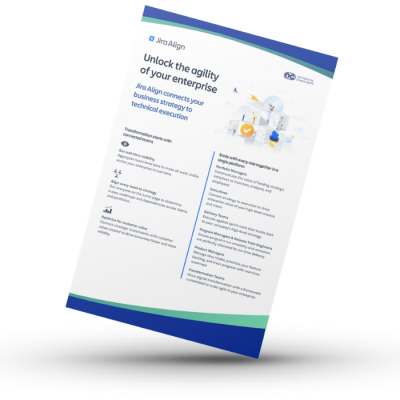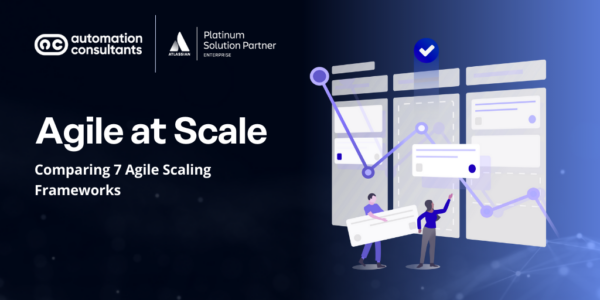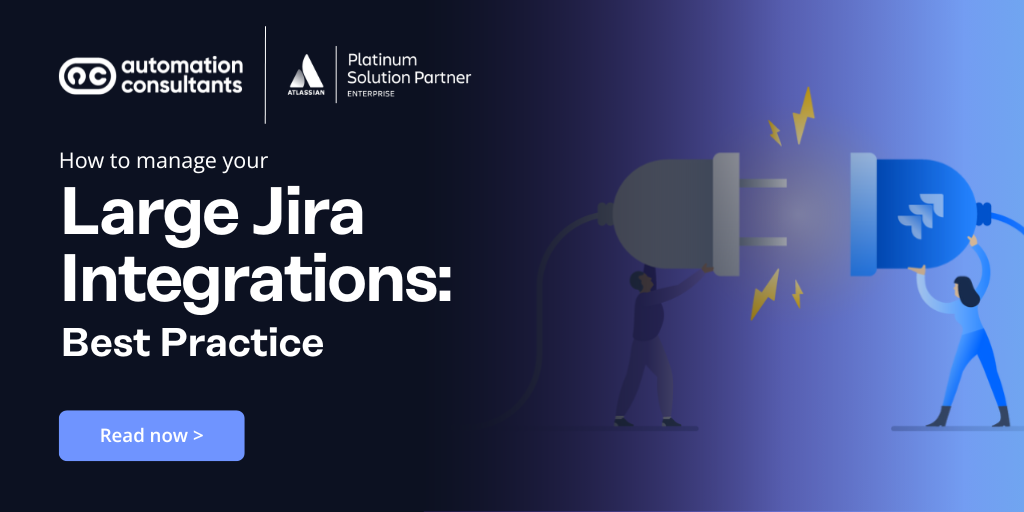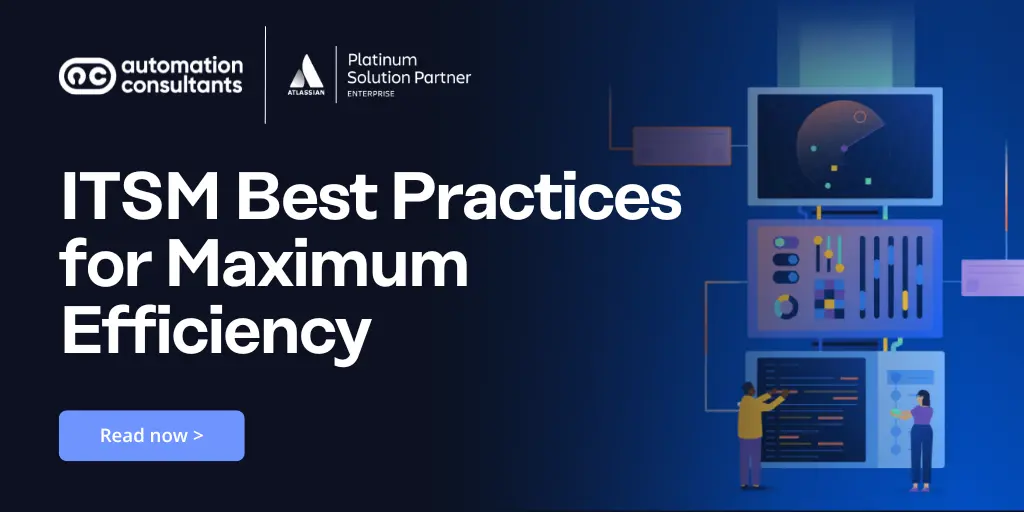The Agile Manifesto, when originally published, did not envisage working at scale.
Instead, it was focused on trying to improve how single teams of developers worked. Imagine teams small enough to gather in a single room and look at a whiteboard together. Now, at that level of scale, there were plenty of ways to improve how software was developed, and the Agile Manifesto focused on these.
Large scale development, however, requires structures to enable many people, who cannot all fit in a room and do not necessarily know each other personally, to work together. This is where Agile at Scale frameworks come in.
Today’s leading Agile at Scale frameworks include:
- Scaled Agile Framework (SAFe)
- Large Scale Scrum (LeSS)
- Disciplined Agile (DA)
- Nexus
- Spotify model
- Scrum at Scale (S@S)
- Enterprise (or Portfolio) Kanban
To provide you with a high-level overview of each of these frameworks, we’ve created this comparison table.
For a more in-depth conversation about Agile transformation, scaling frameworks or best practice, do talk to our team. We can offer a free consultation call to talk through your challenges, aims and objectives – or simply an informal chat if you’d prefer.
Agile at Scale frameworks: A comparison
Framework
Key characteristics 🧬
Strengths ✅
Weaknesses ❎
SAFe
We explore SAFe in more detail over in this short guide here.
Highly structured
Work divided into quarterly Program Increments (PIs)
Teams formed into Agile Release Trains (ARTs)
Levels of scale: Team, Program, Large Solution, Portfolio
Highly structured
Work divided into quarterly Program Increments (PIs)
Teams formed into Agile Release Trains (ARTs)
Levels of scale: Team, Program, Large Solution, Portfolio
Higher proportion of time spent on planning than with other frameworks
Reduced flexibility given to individuals
Arguably less Agile than other frameworks
LeSS
Based on Scrum
Seeks a minimalist, ‘less is more’ approach
Collaboration between teams facilitated through self-organised structures, such as: Just Talk, Communicate in Code, Travellers, Open Space and Communities
Large scale version: LeSS Huge
Less time and cost spent on roles to co-ordinate teams
Enables flexibility
Mature teams can reach high proficiency through continuous improvement
Teams and users are essentially left to work much out for themselves
This can prove effective for teams with a lot of experience in Agile, but others can be left floundering, with little guidance
DA (or DAD)
Allows a lot of choice in comparison to other frameworks, but still from a set of options
Teams can choose their lifecycle, i.e. their day-to-day Agile way of working
Options include Scrum, Kanban and several others
Provides a balance between flexibility and structure
Lack of rigid guidelines may mean that an organisation seeking to implement DA needs outside help
Nexus
A Nexus is a group of 3-9 Scrum teams, with a single Product Owner and a single backlog
Co-ordination between Scrums is entrusted to a Nexus Integration Team.
Daily Scrum of Scrums meeting complements each team’s own Scrum meeting
- As this builds on Scrum, teams which already use Scrum will find familiar concepts in Nexus
Not designed for large-scale use as there is no provision for working above nine Scrum teams – about 100 people.(Nexus+ is intended to extend Nexus to larger scales)
Spotify
Agile teams are organised into Squads, made up of c. 10 people of different skills, e.g. developers, testers, business analysts
Multiple Squads that work on a related feature form a Tribe (<150 people)
A group of people with similar skills in the same Tribe are called a Chapter
Other groups include Guilds and Alliances
Promotes networking and knowledge sharing across teams
Discourages silos by mixing different disciplines in Squads
More of a set of guidelines than a practical ‘How-to’ framework for scaling agile
No example is widely known of an organisation that has adopted the Spotify model
Even Spotify evolved away from it
Scrum@Scale
For more insights into Scrum@Scale, have a look at this blog post.
Relatively new framework, first published in 2017.
As the name implies, it aims to scale Scrum, by making a Scrum of Scrums (4-5 Scrum teams)
For greater scale, a Scrum of Scrums of Scrums
A Scrum Master Cycle coordinates operations (this is the ‘how’)
A Product Owner Cycle co-ordinates the backlog (the ‘what’)
Scales easily by simply adding Scrum teams to a Scrum of Scrums, then up to a Scum of Scrums of Scrums
A set of large-scale roles and ceremonies are clearly spelled out, reducing the need for experimentation at greater scale
Highly linked to Scrum
If your organisation uses Kanban or XP, you would have to adapt to Scrum before being able to use the scaling framework
Enterprise (aka Portfolio) Kanban
Unlike other scaling frameworks, Enterprise Kanban is not primarily designed for software development
Portfolio Kanban can be scaled from Team Level, through Product/Project Level, Portfolio Level and Strategic Level
Strategic Level cards can be thought of as OKRs
The cascading nature of Kanban cards makes traceability easy between team-level tasks and strategic-level objectives
Enterprise Kanban adapts easily to non-software departments and can contribute towards enterprise agility
Enterprise Kanban lacks some of the infrastructure for continuous improvement and measuring velocity present in other frameworks
A closer look at 3 Agile at Scale frameworks
SAFe
Of the main scaling frameworks, SAFe seems to be much the most popular. (It’s hard to find statistics for how many organisations have implemented it compared other models, but when Google Trends research implies it is around 10x as popular as its rival frameworks.)
SAFe provides clear structures and processes. It recommends that Agile teams use Scrum or Kanban, and specifies a number of defined job roles and regular events which should take place. For example, teams are grouped into Agile Release Trains (ART) and every quarter there should be a Program Increment Planning event in which goals for the coming quarter are agreed.
To its critics, SAFe is too prescriptive and inflexible; in a word, ‘un-agile’! Advocates of SAFe, however, praise this detailed framework for keeping teams focused and goals aligned.
As an Atlassian Platinum Solution Partner, we couldn’t write about the SAFe framework without mentioning Jira Align. The platform is developed specifically Agile at Scale methodologies in mind and, with extensive features to enable the alignment of Portfolio, Large Solution and Agile team management, it’s one of the only tools of its kind. Contact us today to talk through with our dedicated team.
Find out more about Jira Align
Download our free Jira Align overview cheat-sheet to find out more about how Jira Align connects your business strategy to technical execution.
LeSS
Large Scale Scrum (LeSS) is at the other end of the scale, when it comes to being prescriptive, in keeping with its slogan ‘More with LeSS’.
Its entire rulebook is said to fit on two sheets of paper, and at its core has ten underlying principles and three principles of guidance on adoption. LeSS is based on Scrum and specifies a few structures to coordinate between teams and handle dependencies, such as an overall retrospective and an all-teams sprint review.
Scrum@Scale
We’ll finish with a closer look at Scrum@Scale. S@S was developed by Jeff Sutherland, one of the original authors of Scrum and a signatory of the Agile Manifesto. It relies heavily on the idea of a Scrum of Scrums (SoS). (Other frameworks, in particular LeSS and Nexus, also use this concept.) An SoS can consist of up to about five Scrum teams.
Above this number, the framework prescribes a Scrum of Scrums of Scrums (SoSoS).
In a Scrum team, the Scrum Master takes care of the smooth running of the processes and ceremonies, while the Product Owner determines what will be developed and the prioritisation of implementing tasks from the backlog. This concept is maintained in S@S by the posts of Scrum of Scrums Master and Chief Product Owner. A set of scaled ceremonies is laid out for SoS which are equivalent to those in a single Scrum Team.
What’s next?
Whichever scaling method is chosen, adopting and implementing it is a significant undertaking for any large organisation. The exact approach varies by framework, so it’s crucial to ensure that you have a dedicated and experienced partner by your side.
In the next article in this series, we will consider in greater detail how to adopt an Agile scaling framework and implement it successfully. Be notified first about our latest blogs by signing up to our newsletter.
In the meantime, if you’d like to explore implementing Agile at Scale in your organisation, or to simply have an initial discussion, our team are always on hand to help. We’re an Atlassian Platinum Solution Partner, specialising in Agile, Dev-Ops and Cloud consultancy, training and managed services.





